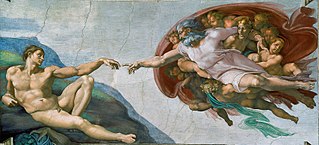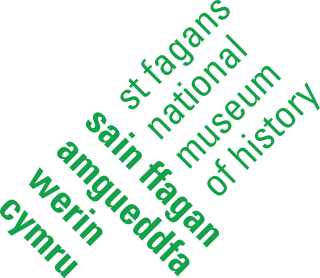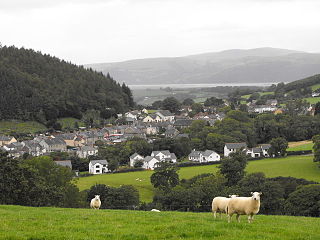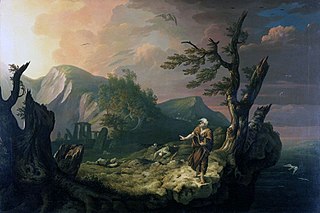

St Teilo's Church is a historic building originally located at Llandeilo Tal-y-Bont near Pontarddulais and now reconstructed at St Fagans National History Museum in Cardiff, Wales. [1]


St Teilo's Church is a historic building originally located at Llandeilo Tal-y-Bont near Pontarddulais and now reconstructed at St Fagans National History Museum in Cardiff, Wales. [1]
The church is thought to have been built in the 12th or 13th century. It was used regularly until 1850, subsequently used only for a few services during the summer months. [2] As recently as the early 20th century, coracles were used by worshippers to reach the church in its location beside the River Loughor. [3] It went out of use in 1970 [4] and began to be demolished in 1984 in readiness for the move to St Fagans.
Prior to the removal of the church, wall paintings were discovered showing through in places beneath the plaster. [5] When the church began to be dismantled, the paintings were first removed and preserved; the oldest of them was a mural of St Catherine, believed to date from the 15th century. [6]
It was rebuilt and redecorated as it would have appeared in about 1530. The new roof timbers were sourced from Northeast Wales and a new rood screen and a loft were carved from Radnorshire oak by the project's head carpenter, Ray Smith MBE. [2]
The missing sections of the wall paintings were reconstructed from what was left. Around one-third of the paintings now displayed are reconstructions of those discovered under the wall-plaster, the originals having been preserved and held by the National Museum of Wales. The remainder were devised by experts, based on paintings known from other churches. One of the original paintings represented the Holy Trinity, with God the Father seated in majesty behind a crucifix. The head of the king is believed to be modelled on King Henry VIII of England, a theory supported by a representation on the opposite wall of Henry's seal. [7]
The church was the 41st building to be opened to the public at the museum. It was officially reopened by the then Archbishop of Canterbury, Dr Rowan Williams, in 2007. [2]

Fresco is a technique of mural painting executed upon freshly laid ("wet") lime plaster. Water is used as the vehicle for the dry-powder pigment to merge with the plaster, and with the setting of the plaster, the painting becomes an integral part of the wall. The word fresco is derived from the Italian adjective fresco meaning "fresh", and may thus be contrasted with fresco-secco or secco mural painting techniques, which are applied to dried plaster, to supplement painting in fresco. The fresco technique has been employed since antiquity and is closely associated with Italian Renaissance painting. The word fresco is commonly and inaccurately used in English to refer to any wall painting regardless of the plaster technology or binding medium. This, in part, contributes to a misconception that the most geographically and temporally common wall painting technology was the painting into wet lime plaster. Even in apparently Buon fresco technology, the use of supplementary organic materials was widespread, if underrecognized.

Llandeilo is a town and community in Carmarthenshire, Wales, situated at the crossing of the River Towy by the A483 on a 19th-century stone bridge. Its population was 1,795 at the 2011 Census. It is adjacent to the westernmost point of the Brecon Beacons National Park. The town is served by Llandeilo railway station on the Heart of Wales Line.

Llanbedr-y-Cennin is a small village in Conwy county borough, Wales, in the community of Caerhun.

St Fagans National Museum of History, commonly referred to as St Fagans after the village where it is located, is an open-air museum in Cardiff chronicling the historical lifestyle, culture, and architecture of the Welsh people. The museum is part of the wider network of Amgueddfa Cymru – National Museum Wales.

Pontarddulais, also known as Pontardulais, is both a community and a town in Swansea, Wales. It is 10 miles (16 km) northwest of the city centre. The Pontarddulais ward is part of the City and County of Swansea. Pontarddulais adjoins the village of Hendy in Carmarthenshire. The built-up population was 9,073.

The Diocese of Llandaff is an Anglican diocese that traces its roots to pre-Reformation times as heir of a Catholic bishopric. It is headed by the Bishop of Llandaff, whose seat is located at the Cathedral Church of Saint Peter and Saint Paul in Llandaff, a suburb of Cardiff. It currently covers most of the former Welsh county of Glamorgan, but once stretched from the River Towy to the middle of the Wye Valley.

The Bishop of Llandaff is the ordinary of the Church in Wales Diocese of Llandaff.

Saint Oudoceus (Latin) or Euddogwy (Welsh) is generally known as the third Bishop of Llandaff in South Wales. In reality he was probably a 7th-century bishop at Llandeilo Fawr. Wendy Davies puts his episcopal reign between about 650 and 700.

Llangynog is a small rural community located in Carmarthenshire, Wales the main settlement of which was once called ‘Ebenezer’village. It is bordered by the communities of: Newchurch and Merthyr; Carmarthen; Llangain; Llansteffan; Laugharne Township; and St Clears, all being in Carmarthenshire. The population at the 2011 census was 492.

Tal-y-bont is a village in Ceredigion, Wales, located on the A487 road about halfway between Aberystwyth and Machynlleth. At the 2011 census the population was 662 with 63% born in Wales. Tal-y-bont is in the community of Ceulanamaesmawr.

Welsh art refers to the traditions in the visual arts associated with Wales and its people. Most art found in, or connected with, Wales is essentially a regional variant of the forms and styles of the rest of the British Isles, a very different situation from that of Welsh literature. The term Art in Wales is often used in the absence of a clear sense of what "Welsh art" is, and to include the very large body of work, especially in landscape art, produced by non-Welsh artists in Wales since the later 18th century.
Llandeilo Llwydarth or Llandilo is an ancient area and parish in the Preseli Hills between Llangolman and Maenclochog in the community of Maenclochog, Pembrokeshire, Wales.

Saint Teilo, also known by his Cornish name Eliud, was a British Christian monk, bishop, and founder of monasteries and churches. He was from Penalun (Penally) near Tenby in Pembrokeshire, south Wales.

Fagan, also known by other names including Fugatius, was a legendary 2nd-century Welsh bishop and saint, said to have been sent by the pope to answer King Lucius's request for baptism and conversion to Christianity. Together with his companion St Deruvian, he was sometimes reckoned as the apostle of Britain.

Deruvian, also known by several other names including Damian, was a possibly legendary 2nd-century bishop and saint, said to have been sent by the pope to answer King Lucius's request for baptism and conversion to Christianity. Together with his companion St Fagan, he was sometimes reckoned as the apostle of Britain. King Lucius's letter may represent earlier traditions but does not appear in surviving sources before the 6th century; the names of the bishops sent to him does not appear in sources older than the early 12th century, when their story was used to support the independence of the bishops of St Davids in Wales and the antiquity of the Glastonbury Abbey in England. The story became widely known following its appearance in Geoffrey of Monmouth's History of the Kings of Britain. This was influential for centuries and its account of SS Fagan and Deruvian was used during the English Reformation to support the claims of both the Catholics and Protestants. Christianity was well-established in Roman Britain by the third century. Some scholars therefore argue the stories preserve a more modest account of the conversion of a Romano-British chieftain, possibly by Roman emissaries by these names.

Llannefydd is a village and community in Conwy County Borough, in Wales. It is located on the border with Denbighshire, between the Afon Aled and River Elwy, 5.7 miles (9.2 km) north west of Denbigh, 5.8 miles (9.3 km) south west of St Asaph, 6.9 miles (11.1 km) south of Abergele and 15.2 miles (24.5 km) south east of Conwy. In the 2011 census the community parish had a population of 590. The community includes the village of Cefn Berain and part of the hamlet of Bont Newydd.
St Teilo's Church may refer to:

Melin Bompren is a water-powered corn mill, originally located at Cross Inn, Cardiganshire, Wales, but now at the St Fagans National History Museum, Cardiff.

The St Teilo's Church, is an Anglican parish church in the town of Llandeilo, Carmarthenshire, Wales. The fabric of the building has medieval origins but stands on a much older site and was rebuilt in the early eighteenth century. It was designated as a Grade II listed building on 14 March 1966

St Tyfi's Church is the former parish church of Llandyfeisant, near Llandeilo and part of the Dinefwr Park estate in Carmarthenshire, Wales. It was dedicated to the Welsh saint Tyfei, nephew of Saint Teilo.
![]() Media related to St Teilo's Church, Llandeilo Tal-y-bont at Wikimedia Commons
Media related to St Teilo's Church, Llandeilo Tal-y-bont at Wikimedia Commons